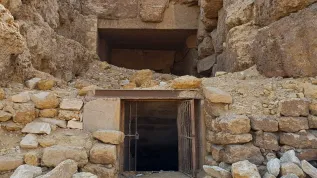
Archaeologists found the foundations of medieval town hall in Radom city square. The location will be specially marked in the revitalization of the square floor, planned by the city for the next year.
Town hall, like Radom castle and parish church, was built in mid-14th century, during the rule of Casimir the Great, who founded Radom according to the Magdeburg Law. This marked the beginning of development of a new Casimir Town.
Chief archaeologist supervising the excavations at the Radom market, Grzegorz Barczyk told PAP that in the study archaeologists uncovered the town hall foundations made of stone with lime mortar.
Barczyk emphasised that excavations confirmed the original location of the town hall. Uncovered foundations indicate that the building on a rectangular plan with dimensions of 21 m by 10.5 m, was situated on the east - west axis.
"We have confirmed that the first town hall in Radom was not located in the centre of the square, as in other medieval Casimir towns, but closer to the western side" - noted the archaeologist.
Hall was situated opposite the existing Lublin Gate and on the extension of today’s Rwańska street, which used to be the road leading to Lublin.
In the beginning of the project, archaeologists were almost certain that the first Radom town hall was located in this part of the market. This was indicated by Samuel Hoppen’s engraving of a view of the town hall dating from 1808 and the plan of the city made by the Sandomierz province engineer Ignacy Ebertowski.
Samuel Hoppen was a pharmacist who lived in the building on the market square opposite the town hall. He drew the view of the building from his window. Hoppen’s sketch is the only view of the old town hall preserved to the present day.
During excavations archaeologists found many fragments of pottery from various periods, from the fourteenth century to the present. These are fragments of pottery and glass vessels, stove tiles. Among the finds are also two mysterious balls of sandstone, with diameters of 7 mm and 10 mm. According to Barczyk, they could be cannon balls, although he noted that cannonballs were usually made of stronger material; they could also be façade ornaments.
Archaeological research is conducted by the municipal company "Revitalization", whose aim is to revitalize the Casimir Town. According to the company\'s CEO Mariusz Mróz, in the coming years, the city plans to conduct revitalization of the city square floor. "We would like to outline the town hall foundations with coloured sett or paving" - added Mróz.
The first town hall was built around Radom in mid-14th century. In the beginning of the 16th century it was rebuilt. The building was destroyed during the Swedish invasion, in the 18th century also destroyed by fire. Rebuilt in 1790, in later years it fell into disrepair. In 1818 the decision was made on its demolition.
New city hall was built on the other side of the square in mid-19th century by the famous architect Henryk Marconi. In recent times, it was the location of the State Archives, moved to new premises in the autumn of 2013.
PAP - Science and Scholarship in Poland
ilp/ abe/ jjj/ mrt/
tr. RL













